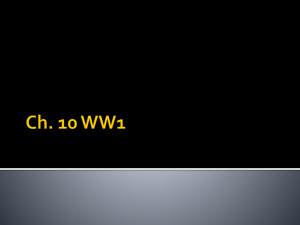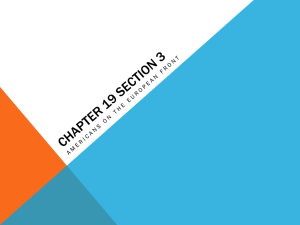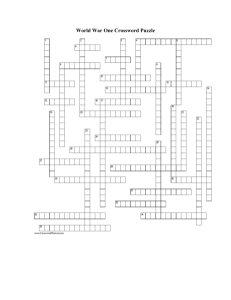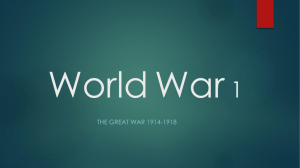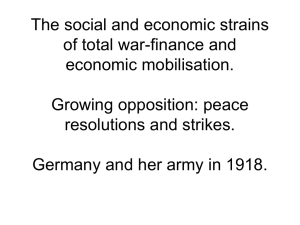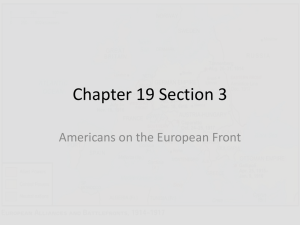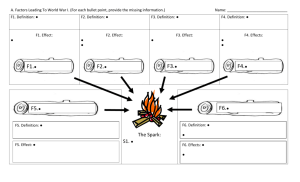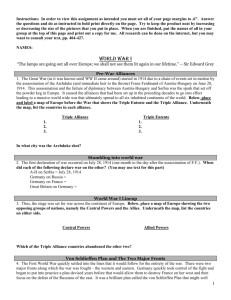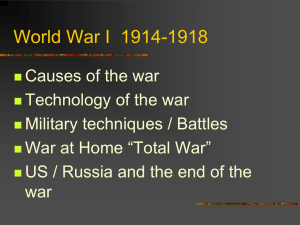WWI - Duplin County Schools
advertisement
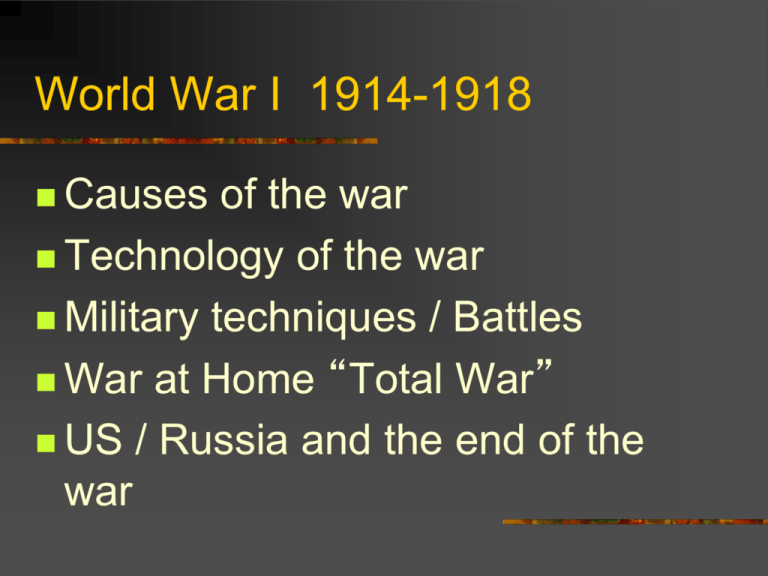
World War I 1914-1918 Causes of the war Technology of the war Military techniques / Battles War at Home “Total War” US / Russia and the end of the war Traditional European Rules of War 1. A country must declare war before attacking another country. 2. Each side must wear uniforms or identify themselves to each other before attacking. Soldiers wearing an enemy uniform will be shot as a spy. Traditional European Rules of War 3. Commanding officers should not be targeted 4. Civilians, Surrendering Soldiers and Medical Personnel will not be attacked. Traditional European Rules of War 5. Hand to Hand combat is honorable, shooting from a distance is cowardly 6. Soldiers must be given the opportunity to surrender honorably. Long Term Causes Nationalism Deep Devotion to One’s Nation Competition and Rivalry developed between European nations for territory and markets Long Term Causes Militarism Glorifying Military Power Keeping a large standing army prepared for war Arms race for military technology Long Term Causes Imperialism European competition for colonies Quest for colonies often almost led to war Imperialism led to rivalry and mistrust amongst European nations Long Term Causes Alliance System- Designed to keep peace in Europe, instead pushed continent towards war Many Alliances made in secret By 1907 two major alliances: Triple Alliance and Triple Entente The Two Sides Triple Alliance Triple Entente Germany Austria-Hungary Italy Central Powers England France Russia Allied Powers Germany Austria-Hungary Ottoman Empire England, France, Russia, United States, Italy, Serbia, Belgium, Switzerland Major Colonies Triple Entente France- Vietnam, Parts of Africa England- Africa, Australia, Hong Kong, India, Canada, S. America Triple Alliance GermanyAfrica, Parts of Asia Short-Term Cause June 28th 1914 Assassination of Franz Ferdinand Who Declared War on Who? Austria-Hungary Declares War on Serbia Russia Declares War on Austria Hungary Germany Declares War on Russia Germany Declares War on France England Declares War on Germany and Austria Hungary By the end of 1914, not only Europe was at war, but also all of Europe’s colonies in Asia, Africa and South America. New Technology Guns The It Machine Gun was used by both sides, hundreds of rounds a minute could be shot by one person. The German plan against France was to rush into the country as fast as possible: The Schlieffen Plan Did not focus on Russia at first because Russia had to mobilize The Machine Gun stopped this plan Trench Warfare Both sides dug long trenches that faced each other. The trenches ran for miles. From time to time, one side would attempt to cross the “No-Man’s Land” the area in between the trenches. Trench warfare made WWI extend from a few months of fighting to four years of fighting French Soldiers Attacking a German Trench Technology: Chemical Weapons WWI was the first major war to use chemical weapons Mustard Gas and Chlorine Gas were the two most popular weapons: They caused suffocation, blindness, and death Soldiers would protect themselves using Gas Masks Technology: The U-boat (Submarine) Germany’s secret weapon during the war Sank dozens of British ships, controlled the oceans. Why would the British think the Uboat was breaking the rules of War ? Technology: Airpower Both sides used aircraft for observation, limited bombing, and air battles Airplanes were slow, clumsy, and unreliable, Technology: Tanks Technology: Tanks The Great War Western Front Germans, Austria-Hungarians vs. French, British and later Americans Germany develops the Schlieffen Plan Battle of the Marne (1914- German Defeat) Trench Warfare on the Western Front Eastern Front Russians and Serbs vs. Germans and Austria-Hungarians War more mobile but still a stalemate Russia’s disadvantages Not Industrialized Short on Supplies Russia’s advantage People Other Fronts Japan, Australia, India join Allies Ottoman Turks, Bulgaria join Central Powers Battles occur in Africa and Asia for Colonial Possessions Russia Exits the War In March 1917, Nicholas II abdicates his throne, the Russian Duma continues to fight. In October 1917: Lenin and the Bolsheviks take command: The Soviet Union is created. March 1918: Soviets and Germans sign the Treaty of Brest-Litovsk, ending the war in the East. US claims Neutrality I didn’t raise my boy to be a soldier I brought him up to be my pride and joy Who dares to place a musket on his shoulder, To shoot some other mother’s darling boy? US Road to War British Blockade did not allow products to leave or enter Germany German U-Boat Response counter to blockade, destroy all boats headed for British shores US Road to War May 7th 1915 Sinking of the Lusitania 1916 Presidential Election And the Winner is… Woodrow Wilson Because “he kept us out of the war” US Road to War The Last Straw Zimmerman Note US Declares War Senate Declares War April 4th 1917 House of Representatives Declares War April 6th 1917 Wilson’s reasoning for War make the world “Safe for Democracy” War on the Homefront World War I as a Total War All Resources devoted to homefront Gov’t took over factories to make Military goods All had to work (Women took place of men in factories) Rationing- limit consumption of resources/goods necessary for the war effort Propaganda- one-sided information to keep support for the war Propaganda US Propaganda Great Britain Propaganda Germany Ending the War 1917-1918 US Enters the War in April of 1917 March 1918 Russia and Germany sign the Treaty of Brest-Litovsk Germans now use all resources on Western Front March of 1918 Germany begins a massive attack on France Ending the War (1918) The Tide Turns German troops fatigued US had 140,000 “fresh” troops 2nd Battle of the Marne (June 1918) Central Powers Crumble Revolutions in Austria Hungary Ottoman Empire surrenders German soldiers mutiny, public turns against Kaiser Wilhelm II Ending the War (1918) Kaiser Wilhelm abdicates on November 9th 1918 11th hour of the 11th day of the 11th month in 1918 Germany agrees to a cease-fire 8.5 million soldiers dead 21 million soldiers wounded Cost of 338 billion dollars Ending the War The Paris Peace Conference Meeting of the “Big Four” at the Paris Peace Conference Wilson Proposes his “14 points” Freedom of the seas End of secret treaties Reduction of national arms Adjustment of colonial claims Self-determination for various nationalities in A-H League of Nations The Treaty of Versailles Germany was disarmed, lost colonies, accepted war guilt, accepted French occupation of Rhineland for 15 years, and paid huge reparations sums. Allies took territories and applied selfdetermination Estonia, Latvia, Lithuania, Finland, and Poland granted independence Czechoslovakia and Yugoslavia established Signers would join League of Nations League of Nations US ultimately rejected the League of Nations, led by Senate leader Henry Cabot Lodge US did not ratify Treaty of Versailles or join the League of Nations Effects of World War I After the war, feelings of pessimism were prevalent. Demobilization- forced women and African Americans out of jobs when soldiers returned Recession due to slowing industry Race riots Red Scare- fear of communism; Attorney General, A. Mitchell Palmer, ordered mass arrests of anarchists (Palmer Raids)

